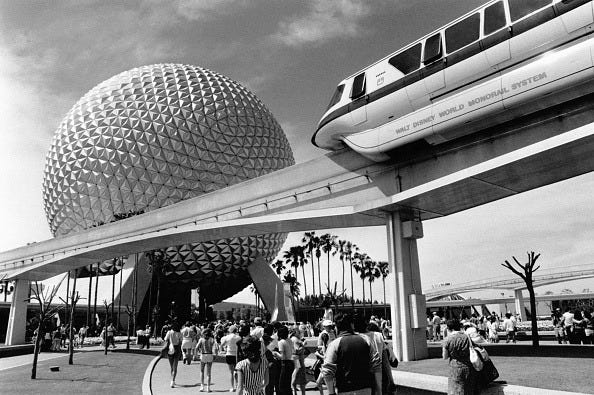The Four Ages of Communication: How Changing Media Transforms the Human Experience
Take an illuminating ride through the Dying Breed version of Epcot Center
Like most kids who grew up in the 90s watching Double Dare, I coveted the prize package that included a trip to Disney World. Specifically, I wanted to go to Epcot Center to check out that big golf ball building, Spaceship Earth. What was inside it? It had to be cool and futuristic. The building is a geodesic sphere!
I was able to fulfill this childhood wish in my early twenties. Kate's uncle worked for Disney and snagged us free passes to all the parks. We spent three days staying in a condo with Kate’s grandparents and doing Disney. It was awesome.
The day we went to Epcot, I made a beeline to Spaceship Earth. I had to see the interior.
Well, come to find out, there were no cool futuristic gizmos inside Spaceship Earth.
Rather, it was a slow, 15-minute Omnimover ride filled with animatronics that took you through the history of human communication, beginning with caveman paintings and ending with personal computers — all narrated by English actor Jeremy Irons.
I was admittedly disappointed. At least the 10-year-old Brett still living inside 23-year-old Brett's body was disappointed.
You're telling me they built a giant futuristic golf ball building just for a ride about the history of communication? Come on!
Despite the letdown, I had to admit that the history of human communication is actually really dang interesting and underappreciated. Each advancement in communication not only reshaped our interactions, but how societies functioned.
Now that I’m older, and have dug deeper into the writings of media theorists like Marshall McLuhan, Walter Ong, and Neil Postman, I've also learned that changes in how we communicate reshape how we think and our very sense of self.
Back in January, I introduced some of these ideas in my article about Twitter brain and Nietzsche's typewriter. Today, I'd like to flesh out a Spaceship Earth-esque history of human communication as proposed by the thinkers I just mentioned. They and other scholars argue that with each evolution in communication mediums — from oral speech, to writing and print, to broadcast media, and finally to digital media — humanity experienced a corresponding shift in cognition and culture. Understanding these shifts and their consequences can help you better understand your world and how you and others make sense of it. It will also set us up for more in-depth media theory articles to come.
So hop on the train. Please be sure your seatbelts are securely fastened and your hands are inside the vehicle. Get ready for an enlightening ride through the history of human communication.



